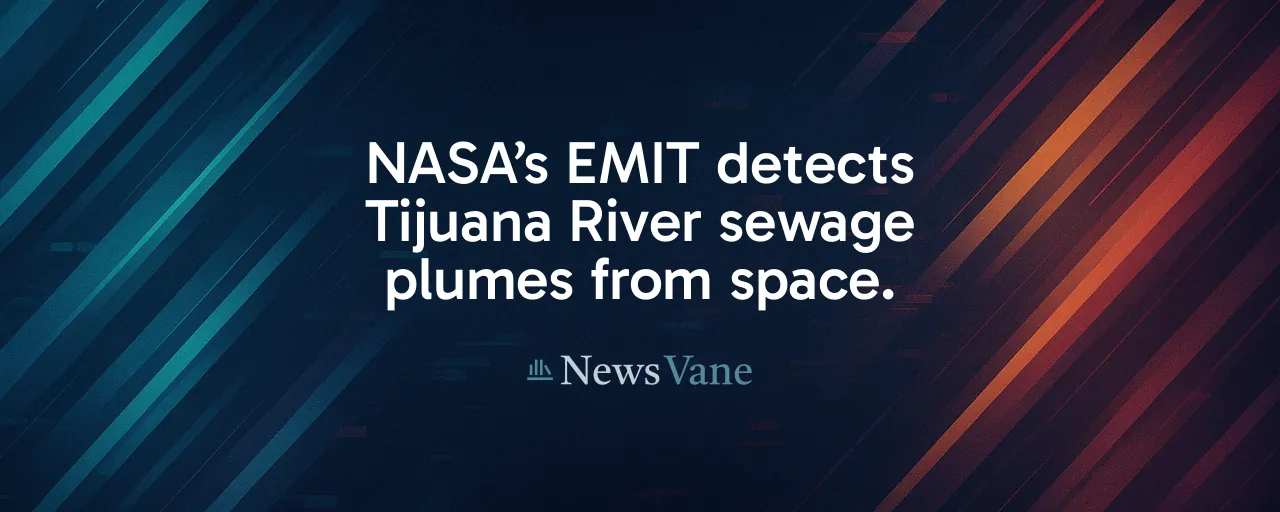A Hidden Crisis in Plain Sight
The Pacific Ocean sparkles under the California sun, its waves inviting surfers and beachgoers. Yet just beneath the surface, a serious problem flows unchecked. Each year, the Tijuana River carries millions of gallons of sewage into the sea, spreading bacteria that endanger people and wildlife. A surprising ally in understanding this threat comes from space, where a NASA tool is shedding new light on the issue.
The Earth Surface Mineral Dust Source Investigation, known as EMIT, orbits Earth on the International Space Station. Originally built to study desert minerals, it has proven adept at detecting coastal pollution. A recent study revealed EMIT's ability to identify sewage in the ocean, offering a clearer picture of a problem that has plagued the U.S.-Mexico border for decades.
The Tijuana River crosses from Mexico into California, passing through communities and a national reserve before reaching the Pacific. Its waters carry both treated and untreated wastewater, contaminating beaches and harming marine life. From swimmers to Navy trainees, the risks touch many, making EMIT's findings a vital step toward addressing the crisis.
Seeing Pollution From Space
EMIT relies on hyperspectral imaging, which captures light across hundreds of wavelengths. This technology identifies specific substances by their unique spectral signatures. In the Tijuana River study, EMIT detected phycocyanin, a pigment in cyanobacteria that can sicken humans and animals through ingestion or inhalation.
Researchers verified EMIT's findings by testing water samples on the ground. Both approaches confirmed cyanobacteria in the sewage plume, proving the tool's reliability. This capability allows scientists to monitor vast coastal areas that are difficult to sample manually, saving time and effort compared to traditional methods.
Satellites have long tracked water quality, using ocean color to spot algal blooms. However, identifying subtler contaminants like bacteria has been challenging. EMIT's detailed spectral data and high resolution enable it to detect pollutants that older sensors overlook, marking a significant advance in environmental monitoring.
Tackling a Complex Challenge
The Tijuana River's pollution reflects broader issues with wastewater management. In the U.S., aging sewer systems face growing strain from population growth and extreme weather. The American Society of Civil Engineers reports a $69 billion annual funding shortfall for wastewater infrastructure, with climate-driven storms worsening overflows that send untreated waste into waterways.
Solutions vary by perspective. Advocates for robust federal oversight point to the Clean Water Act's role in reducing pollution since the 1970s. Others prioritize infrastructure upgrades, such as the $300 million allocated through the U.S.-Mexico-Canada Agreement to improve sewage treatment in the Tijuana region. Both approaches aim to curb the flow of contaminants.
Cross-border cooperation is essential. The U.S. and Mexico work together through initiatives like Border 2025, building on treaties from 1944. These efforts fund joint projects to address water and air pollution, but challenges like funding shortages and coordination persist, leaving communities vulnerable to ongoing contamination.
The Real-World Impact
Sewage pollution carries serious consequences. Contaminated water is linked to illnesses like gastroenteritis and ear infections, particularly for those who swim or surf. In April 2025, California closed beaches from Imperial Beach to Coronado after Tijuana released millions of gallons of untreated sewage, highlighting the public health stakes.
Marine ecosystems face equal harm. Sewage fuels algal blooms that deplete oxygen and release toxins, killing fish and marine mammals. These disruptions cost fisheries millions each year, while beach closures hurt tourism and local economies, especially in coastal towns reliant on visitors.
The threat doesn't stop at the shore. Research shows that bacteria in polluted surf can become airborne, spreading inland and exposing more people. Tools like EMIT provide critical data to help communities respond before contamination escalates, protecting both health and the environment.
A Path Forward
EMIT's ability to track sewage plumes signals a bright future for hyperspectral imaging. Emerging satellite networks promise even sharper resolution and daily global coverage, enabling utilities to detect contamination early. These advancements could transform how water quality is monitored, offering faster, broader insights than lab-based sampling.
Technology is only part of the answer. Cleaner coasts require sustained investment in wastewater infrastructure, stronger international partnerships, and policies that address local and global needs. The Tijuana River's pollution is a reminder that water quality is a collective challenge, demanding action from all sides.
For now, EMIT provides a powerful tool to confront this crisis. As scientists refine these technologies and communities demand change, there's reason to hope for healthier oceans and safer beaches. The work is far from over, but the path to cleaner water is becoming clearer.
